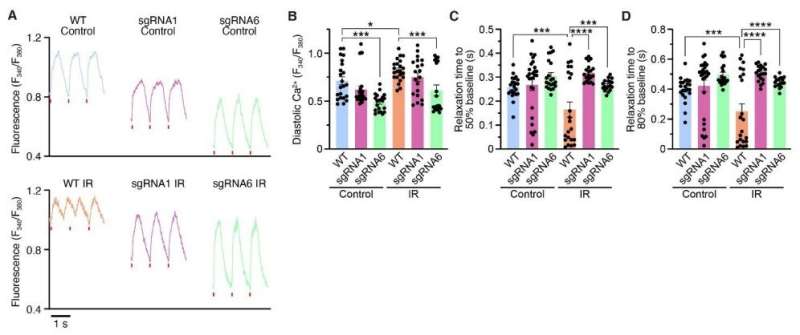January 20, 2023 report
This article has been reviewed according to Science X's editorial process and policies. Editors have highlighted the following attributes while ensuring the content's credibility:
fact-checked
peer-reviewed publication
trusted source
proofread
Using CRISPR-Cas9 as an intervention to protect the heart from ischemia-reperfusion damage

A team of researchers at the University of Texas Southwestern Medical Center has found that it is possible in mice to protect the heart from ischemia-reperfusion using the CRISPR-Cas9 gene editing system. In their paper published in the journal Science, the group describes using the gene editing system to modify two bases in the mouse genome to prevent hyperactivation of a protein that can lead to heart disease.
Prior research has shown that some people have a gene variant that makes them more susceptible to hyperactivation of a protein called CaMKII delta (an event called ischemia-reperfusion) in the later stages of life. Such hyperactivation can lead to an irregular heartbeat and sometimes heart failure. In such cases, heart muscle and tissue can be damaged, killing the patient or leaving them with a less effective heart. In this new effort, the researchers used gene editing to swap out gene components behind the onset of hyperactivation and to replace them with gene bases from a donor who does not have the variant.
The researchers chose to use the CRISPR-Cas9 gene editing system to swap the gene bases, utilizing what they describe as a "fine-tipped ablation pen" on a mouse model. In their work, they conducted two experiments. In the first, they swapped out the variants in the mice prior to a hyperactivation event to see if it would prevent such events from occurring. In the second, they performed the swap after an event to see if doing so might help the heart recover.
They found that the first experiment reduced the chances of a hyperactivation event to nearly zero, and that the second resulted in improved healing and better recovery, resulting in less permanent damage.
The researchers also performed the same type of editing on human genes in stem cells in a petri dish and found that the editing process appeared to work the same as it did in the mice cells. More work is required, as gene editing is still in its infancy and CRISPR-Cas9 does not always perform edits as reliably as would be needed for its use in human patients.
More information: Simon Lebek et al, Ablation of CaMKIIδ oxidation by CRISPR-Cas9 base editing as a therapy for cardiac disease, Science (2023). DOI: 10.1126/science.ade1105
© 2023 Science X Network




















